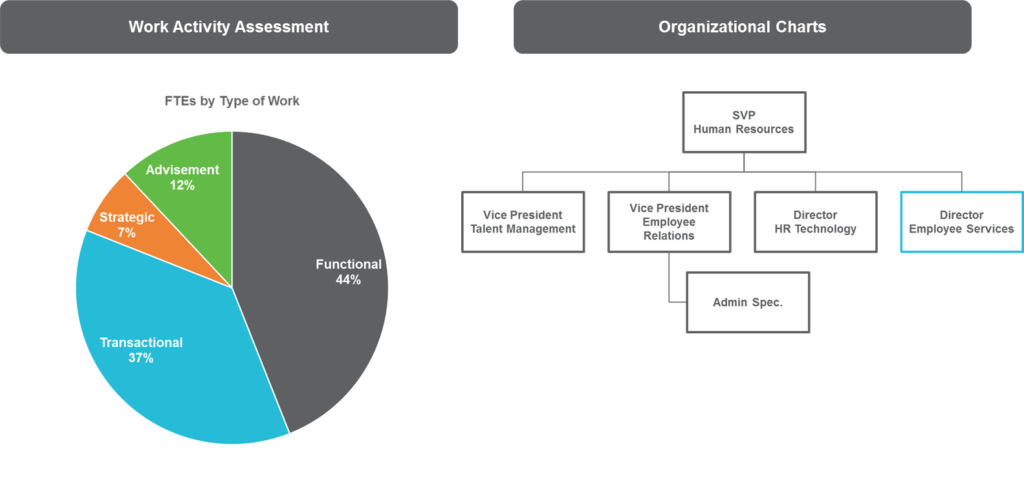
Shared services is a proven method for delivering support services. When organizations implement a shared services model, they typically see benefits that include improved service and scalability, improved leverage over enterprise data, and better control over costs. Before you make the transition to a shared services model, you’ll have to make the case to management. This article presents our recommended approach to developing the business case for shared services.
Key Questions to Ask
A well-constructed business case includes three steps: calculating the benefits, identifying the incurred costs, and developing the cost/benefit and sensitivity analyses. Before diving into the numbers, we recommend reviewing a few key questions, as the answers may affect how you consider and build your business case.
Benefits
- What is the best approach to benchmark process efficiencies for your organization—third-party benchmarks, internal benchmarking, or custom studies?
- Beyond headcount reduction, what other quantifiable benefits can be achieved in implementing shared services?
Cost
- What major groupings of costs should be considered?
- Is it important for your organization to separate recurring costs from non-recurring ones?
- Will internal resources supporting the project be treated as a cost?
Analysis and Sensitivities
- What are the key variables the business is most concerned about (e.g., technology costs, ability to reduce headcount, site location, etc.)?
- How does timing impact the initiative’s ability to generate benefit for the organization?
Recommended Approach
Before the business case can be created, it is important to assess the current state and develop the future state design. The results of these two steps are key inputs to the business case model as shown in Figure 1.
Figure 1: Recommended Approach for Developing a Business Case

Let’s dive deeper into each of these steps.
Assessing the Current State
Understanding the current state starts with capturing headcount. Headcount and FTEs are the basis of many benchmarks and therefore a critical ingredient for any analysis to drive the business case. FTE data can be collected manually or via an online survey tool. For example, an online work activity assessment is a survey that captures actual, rather than perceived, time data across the organization.
As illustrated in Figure 2, work activity assessment results can be combined with personnel labor cost data and correlated with organizational charts to provide a structured headcount per group. The output allows you to summarize FTEs and labor costs by functional area, process, type of work, and position across the enterprise. When paired with benchmarks, you can gain valuable insight and highlight potential areas of opportunity. During the current state assessment, it is also important to understand current processes and technologies and collect volume metrics to benchmark and assess current productivity.
Figure 2: Tools for Determining Headcount by Activity

Developing the Future State
After you complete the current state assessment, you should plan what your organization will look like with shared services implemented and design the future state. Using the opportunities identified in the current state assessment, the future state design should consider assumed process efficiencies to determine staffing levels and costs. The design should also include future uses of technology—both current and new technologies. Another important consideration is the potential location for the future shared services operations. Finally, you will need to think about the time required and support needed to implement the model.
Creating the Business Case
Armed with an assessment of the current state and the design of the future state for your organization, you are ready to create the business case. Start by calculating the benefits, identifying the costs, and then run the cost-benefit and sensitivity analyses to evaluate the financial metrics and show the range of possible results.
Calculating the Benefits
We recommend capturing both hard and soft benefits in the business case. The largest and most important hard benefits are often labor savings. These savings can be found in base salary, bonuses, incentive compensation, and fringe benefits. Beyond simply reducing headcount, labor arbitrage opportunities can create additional savings.
Other hard benefits often fall into three categories: technology savings with the sunset of older platforms or redundant licenses, vendor savings associated with the consolidation and optimization of contracts across the organization, and site savings associated with the reduction of facility costs. Not all implementations will realize all of these hard benefits, but it’s a good practice to examine the opportunities in your organization.
Beyond the hard benefits above, there are also a number of intangible benefits that should be showcased, even if they cannot be quantified in the business case. Shared services advances operations by providing better service and improving customer satisfaction. With a “one-stop shop,” shared services offers better accessibility, too. Shared services brings more accurate and predictable costs for support functions and incorporates more consistent internal controls. Controls are improved through data centralization and consistent processes. This reduces risk to the organization and improves transparency and compliance in processes, especially when coupled with process automation. Shared services also enables strategic decision making by allowing business partners to focus on more strategic work. The enterprise benefits from improved scalability and nimbleness for acquisitions and managing business pressures. Often, there are other indirect efficiencies that expand to other parts of the business due to improved accuracy and speed of service.
While the hard benefits will support the financial analyses and help you build the business case for shared services, the soft benefits can illustrate broad improvements felt across the organization.
Identifying the Costs
When calculating the costs of a shared services initiative, we find that unlike the hard benefits, costs are spread more evenly among headcount, technology, and other areas. Labor costs are impacted by several factors, including new hire salaries, retention rates, the costs and timing of hires and terminations, internal transfers in and out, and internal project team costs and composition. Technology costs typically include one-time setup costs and ongoing maintenance, in addition to new license or hosting costs. You may also incur project support costs from the consulting and project teams, internal marketing services, and the development and execution of training. Lastly, costs should be included for site leasing and renovation, new furniture, fixture and equipment costs, and site selection travel costs. While considering the different sources of costs, it’s also important to consider whether those costs are recurring or one-time investments to better allocate costs and understand future state ongoing costs.
Developing the Cost/Benefit and Sensitivity Analyses
Most organizations use one or more financial metrics to evaluate and prioritize their initiatives, such as net present value, payback period, or internal rate of return. After calculating the costs and quantifying the benefits of the future state design, a well-designed project timeline establishes the sequence and timing of cash flows to calculate these metrics. In addition, the timeline helps to plan for resource needs and understand critical-path task dependencies.
In this step, it is also important to evaluate the sensitivities of the model. Developing comprehensive sensitivities for the business case enables the project team to sell the concept internally in the organization by showing the range of possible results from the initiative. For one, it is easier to disagree and dispute a single dollar value result and much harder to dispute a range. These ranges, as shown in Figure 3 below, illuminate the largest areas of risk and gauge what it would take for the business case to lose appeal. The intent is not to give the appearance that all the variables have been figured out, but that there may still be areas of change.
Figure 3: Example Sensitivity Analysis

Conclusion
We’ve reviewed our recommended approach for creating a robust business case for shared services, which includes assessing the current state, developing the future state, and creating the resulting business case. As all three steps are interconnected, it’s important to consider the implications of each as you progress. Both the costs and benefits of the new model are important, and focusing on both will ensure a balanced approach. While the business case development can be extensive, this process will help you think through the details of implementation so that your plans are as realistic as possible. A clear-eyed view of the model’s sensitivities will identify where to devote the most effort to ensure a successful implementation. When management evaluates the financial implications, a thorough business case will help you be successful as you transform to a shared services model.
Additional Contributing Author: Ben Thayer

